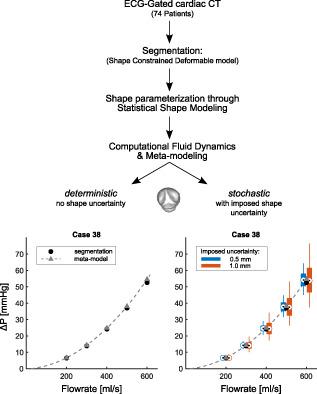当前位置:
X-MOL 学术
›
Int. J. Numer. Method. Biomed. Eng.
›
论文详情
Our official English website, www.x-mol.net, welcomes your
feedback! (Note: you will need to create a separate account there.)
The impact of shape uncertainty on aortic-valve pressure-drop computations
International Journal for Numerical Methods in Biomedical Engineering ( IF 2.2 ) Pub Date : 2021-08-05 , DOI: 10.1002/cnm.3518 M J M M Hoeijmakers 1, 2 , W Huberts 1, 3 , M C M Rutten 1 , F N van de Vosse 1
International Journal for Numerical Methods in Biomedical Engineering ( IF 2.2 ) Pub Date : 2021-08-05 , DOI: 10.1002/cnm.3518 M J M M Hoeijmakers 1, 2 , W Huberts 1, 3 , M C M Rutten 1 , F N van de Vosse 1
Affiliation

|
Patient-specific image-based computational fluid dynamics (CFD) is widely adopted in the cardiovascular research community to study hemodynamics, and will become increasingly important for personalized medicine. However, segmentation of the flow domain is not exact and geometric uncertainty can be expected which propagates through the computational model, leading to uncertainty in model output. Seventy-four aortic-valves were segmented from computed tomography images at peak systole. Statistical shape modeling was used to obtain an approximate parameterization of the original segmentations. This parameterization was used to train a meta-model that related the first five shape mode coefficients and flowrate to the CFD-computed transvalvular pressure-drop. Consequently, shape uncertainty in the order of 0.5 and 1.0 mm was emulated by introducing uncertainty in the shape mode coefficients. A global variance-based sensitivity analysis was performed to quantify output uncertainty and to determine relative importance of the shape modes. The first shape mode captured the opening/closing behavior of the valve and uncertainty in this mode coefficient accounted for more than 90% of the output variance. However, sensitivity to shape uncertainty is patient-specific, and the relative importance of the fourth shape mode coefficient tended to increase with increases in valvular area. These results show that geometric uncertainty in the order of image voxel size may lead to substantial uncertainty in CFD-computed transvalvular pressure-drops. Moreover, this illustrates that it is essential to assess the impact of geometric uncertainty on model output, and that this should be thoroughly quantified for applications that wish to use image-based CFD models.
中文翻译:

形状不确定性对主动脉瓣压降计算的影响
基于患者特定图像的计算流体动力学 (CFD) 在心血管研究界被广泛用于研究血流动力学,并且对于个性化医疗将变得越来越重要。然而,流域的分割并不精确,并且可以预期几何不确定性会通过计算模型传播,从而导致模型输出的不确定性。在收缩期峰值从计算机断层扫描图像中分割出 74 个主动脉瓣。统计形状建模用于获得原始分割的近似参数化。该参数化用于训练将前五个形状模式系数和流量与 CFD 计算的跨瓣压降相关联的元模型。因此,形状不确定性大约为 0.5 和 1。通过在形状模式系数中引入不确定性来模拟 0 mm。执行基于全局方差的敏感性分析以量化输出不确定性并确定形状模式的相对重要性。第一个形状模式捕获了阀门的打开/关闭行为,该模式系数的不确定性占输出方差的 90% 以上。然而,对形状不确定性的敏感性因患者而异,第四形状模式系数的相对重要性往往随着瓣膜面积的增加而增加。这些结果表明,图像体素大小顺序的几何不确定性可能会导致 CFD 计算的跨瓣压降存在很大的不确定性。此外,这表明评估几何不确定性对模型输出的影响至关重要,
更新日期:2021-10-09
中文翻译:

形状不确定性对主动脉瓣压降计算的影响
基于患者特定图像的计算流体动力学 (CFD) 在心血管研究界被广泛用于研究血流动力学,并且对于个性化医疗将变得越来越重要。然而,流域的分割并不精确,并且可以预期几何不确定性会通过计算模型传播,从而导致模型输出的不确定性。在收缩期峰值从计算机断层扫描图像中分割出 74 个主动脉瓣。统计形状建模用于获得原始分割的近似参数化。该参数化用于训练将前五个形状模式系数和流量与 CFD 计算的跨瓣压降相关联的元模型。因此,形状不确定性大约为 0.5 和 1。通过在形状模式系数中引入不确定性来模拟 0 mm。执行基于全局方差的敏感性分析以量化输出不确定性并确定形状模式的相对重要性。第一个形状模式捕获了阀门的打开/关闭行为,该模式系数的不确定性占输出方差的 90% 以上。然而,对形状不确定性的敏感性因患者而异,第四形状模式系数的相对重要性往往随着瓣膜面积的增加而增加。这些结果表明,图像体素大小顺序的几何不确定性可能会导致 CFD 计算的跨瓣压降存在很大的不确定性。此外,这表明评估几何不确定性对模型输出的影响至关重要,











































 京公网安备 11010802027423号
京公网安备 11010802027423号